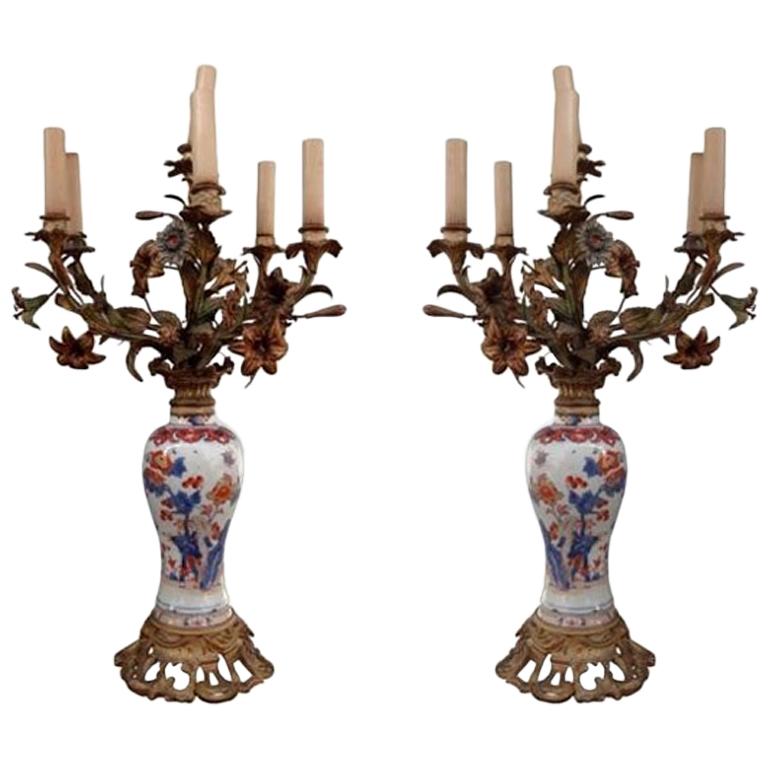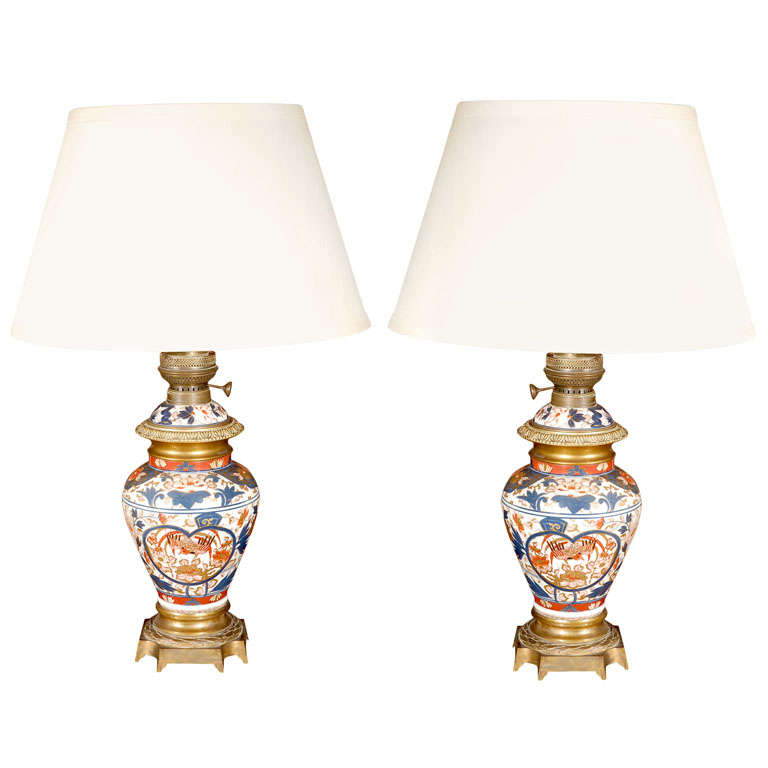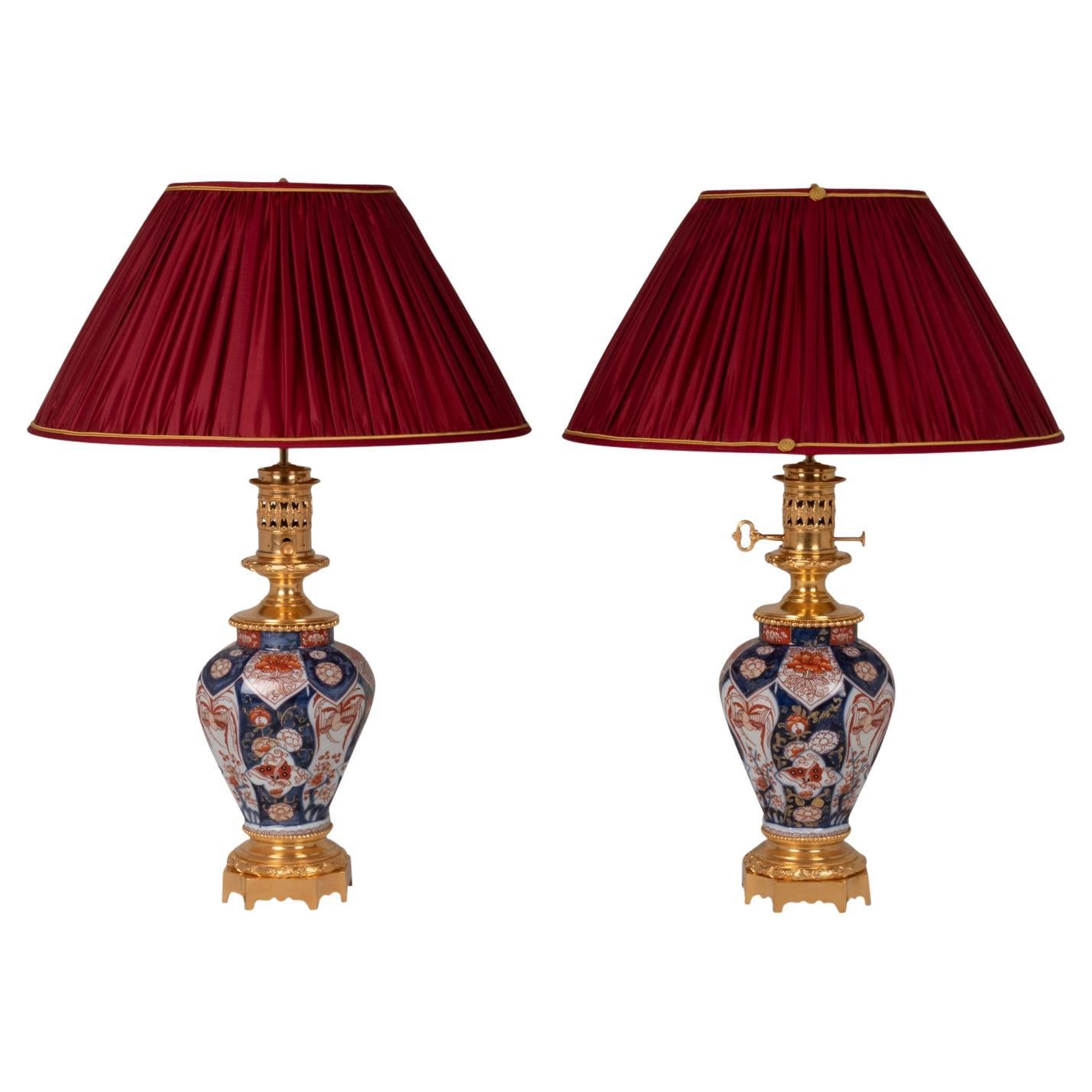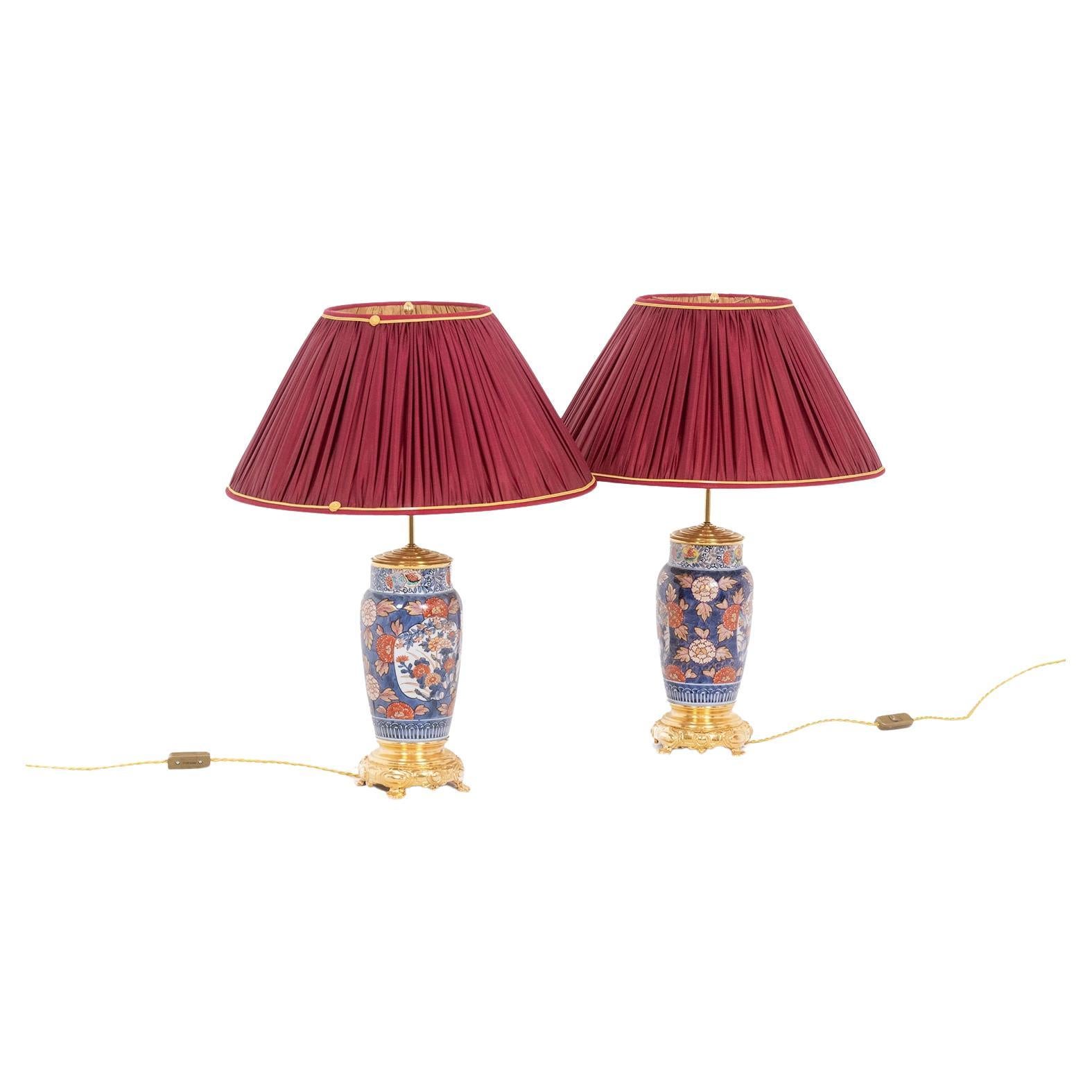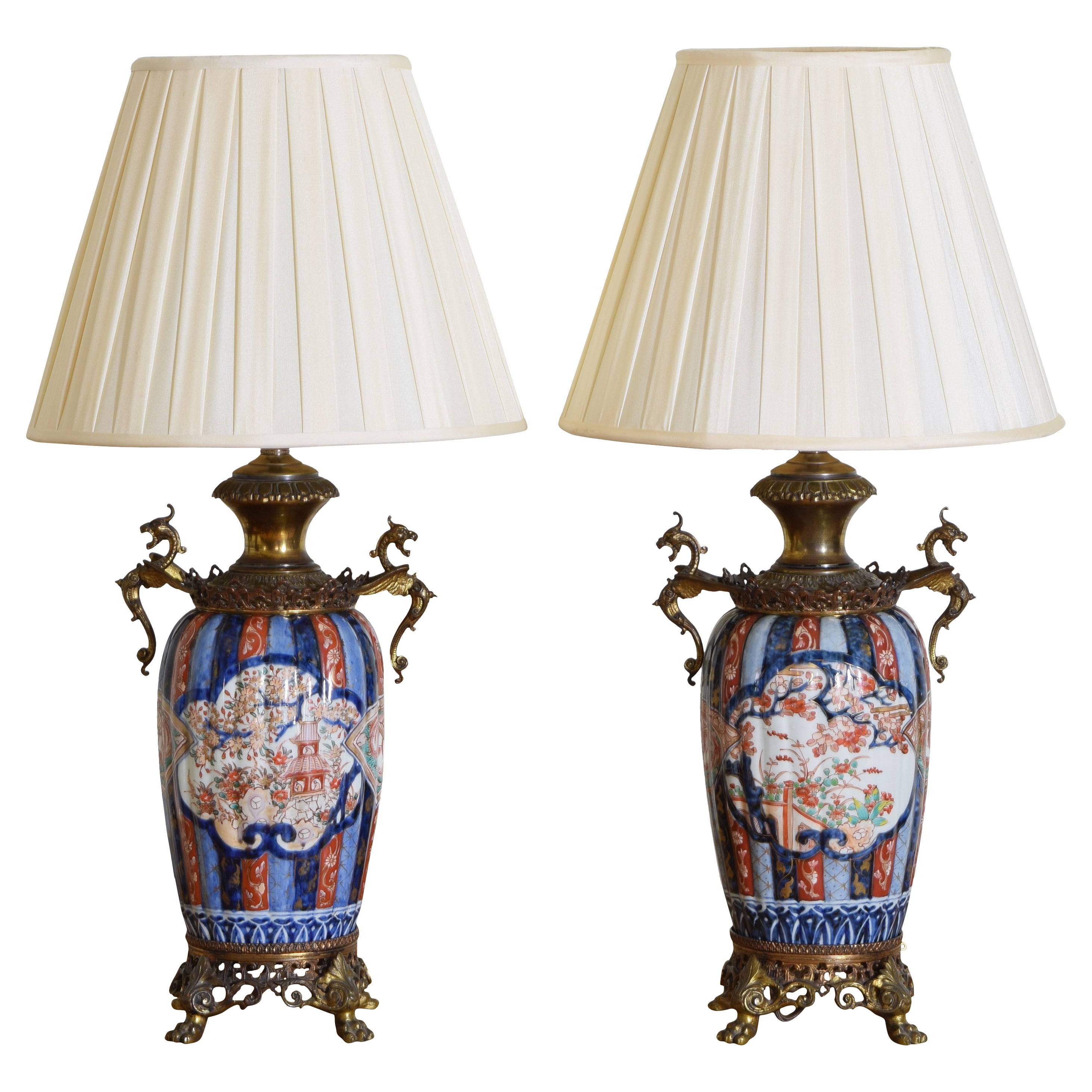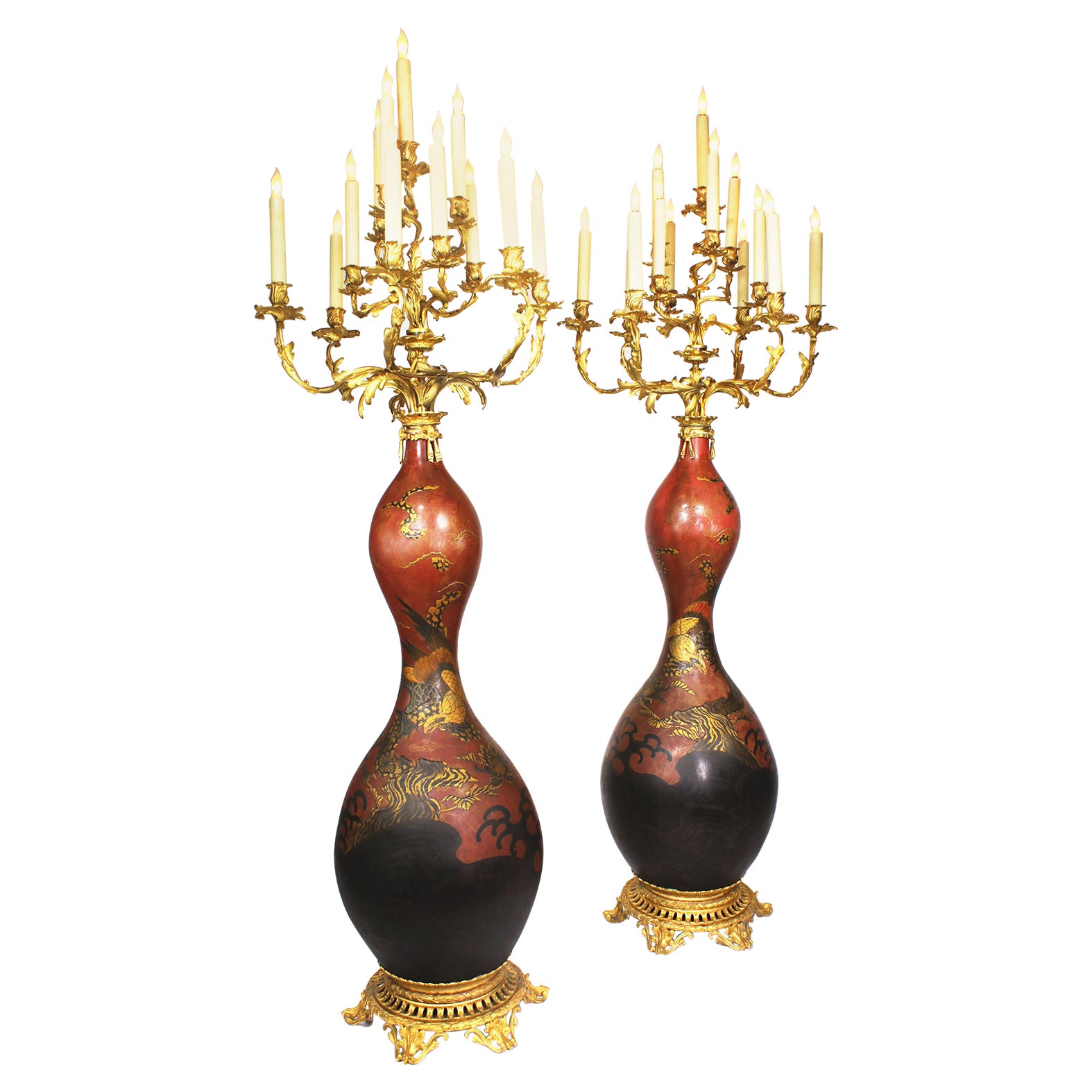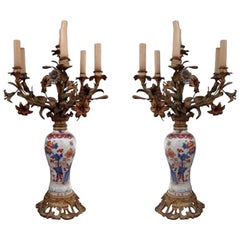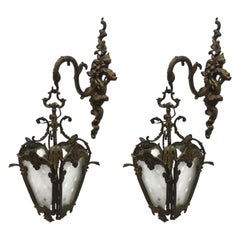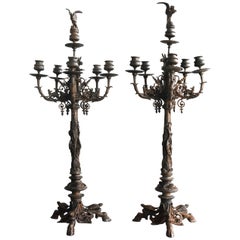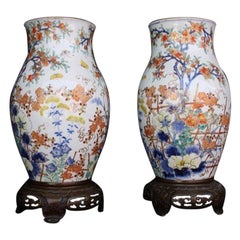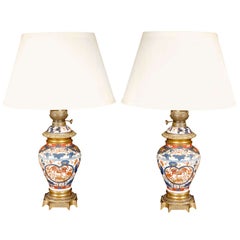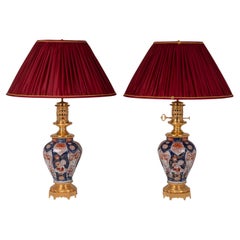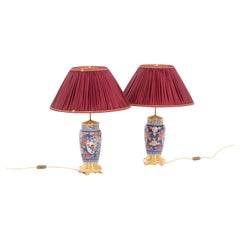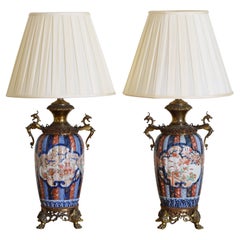Items Similar to Pair of Imari Lamps Mounted in 19th Century Bronze
Want more images or videos?
Request additional images or videos from the seller
1 of 5
Pair of Imari Lamps Mounted in 19th Century Bronze
$7,730.91per set
£5,757.74per set
€6,500per set
CA$10,842.99per set
A$11,893.72per set
CHF 6,133.14per set
MX$142,058.62per set
NOK 77,786.90per set
SEK 72,972.94per set
DKK 49,545.87per set
About the Item
Pair of Arita porcelain lamp called Imari on gilt bronze frame decorated with flowers in polychrome sheet metal from the 19th century. Imari porcelain is a style of Japanese ceramics made in the former province of Hizen on the island of Kyushu, which roughly corresponds to the domain of Saga, and mainly in the kilns of the city of Arita
Additional information:
Material: Bronze
Style: Asian.
- Dimensions:Height: 29.93 in (76 cm)Diameter: 14.18 in (36 cm)
- Sold As:Set of 2
- Materials and Techniques:
- Place of Origin:
- Period:
- Date of Manufacture:19th Century
- Condition:
- Seller Location:Marseille, FR
- Reference Number:Seller: 119391stDibs: LU4057329553992
About the Seller
4.4
Vetted Professional Seller
Every seller passes strict standards for authenticity and reliability
Established in 1999
1stDibs seller since 2018
81 sales on 1stDibs
Typical response time: 1 to 2 days
- ShippingRetrieving quote...Shipping from: Marseille, France
- Return Policy
Authenticity Guarantee
In the unlikely event there’s an issue with an item’s authenticity, contact us within 1 year for a full refund. DetailsMoney-Back Guarantee
If your item is not as described, is damaged in transit, or does not arrive, contact us within 7 days for a full refund. Details24-Hour Cancellation
You have a 24-hour grace period in which to reconsider your purchase, with no questions asked.Vetted Professional Sellers
Our world-class sellers must adhere to strict standards for service and quality, maintaining the integrity of our listings.Price-Match Guarantee
If you find that a seller listed the same item for a lower price elsewhere, we’ll match it.Trusted Global Delivery
Our best-in-class carrier network provides specialized shipping options worldwide, including custom delivery.More From This Seller
View All19th Century Pair of Imari Porcelaine Lamp Mounted Gilt Bronze
By Imari Porcelain
Located in Marseille, FR
19th century pair of porcelain lamp from Imari. Frame gilt bronze decorations of metal polychrome flowers.
Category
Antique 19th Century Chinese Chinese Export Ceramics
Materials
Porcelain
Pair of Bronze Lantern Sconces, Early 20th Century
Located in Marseille, FR
Pair of early 20th century bronze lantern sconces in the Louis XV style, height dimension with 60 cm chain for a width of 20 cm and ...
Category
20th Century Louis XV Wall Lights and Sconces
Materials
Copper
19th Pair of Large Bronze Candlesticks by Jules Moigniez
By Jules Moigniez
Located in Marseille, FR
Pair of large bronze candlesticks decorated with animals and waders by Jules Moigniez patina remake of the late 19th century.
Category
Antique 19th Century Napoleon III More Lighting
Materials
Bronze
Pair of Chinese Vases Mounted as a 19th Century Lamp
Located in Marseille, FR
Pair of Chinese vase (Canton) mounted as a lamp (bronze base and neckline) from the 19th century, height 31 cm.
Additional information:
Material: Earthenware & Ceramics.
Category
Antique 19th Century Chinese Vases
Materials
Earthenware
Pair of Hollandaise Sconces in Silvered Bronze 2 Lights
Located in Marseille, FR
Pair of Dutch sconces in silvered bronze 2 lights measuring 46 cm by 35 cm and 20 cm deep.
Additional information:
Material: Bronze
Style: 1940s to 1960s.
Category
20th Century Wall Lights and Sconces
Materials
Bronze
Pair of French 19th Century Louis XVI Style Figural Wall Lights
Located in Marseille, FR
A very fine pair of French 19th century Louis XVI style gilt bronze two-light figural wall lights (Sconces - Appliqués). Each with goat-head surmounted by a fruit basket and acanthus...
Category
Antique 19th Century French Louis XVI Wall Lights and Sconces
Materials
Bronze
You May Also Like
Antique Pair of Imari Lamps
Located in Los Angeles, CA
19th century, hand painted porcelain Imari vases, with gilt bronze mounts. Formerly gas-lamps, but wired for export. Rich coloring and lush floral motif with birds throughout.
Category
Antique 19th Century Japanese Table Lamps
Materials
Bronze
$8,900 / set
Pair of Lamps in Imari Porcelain and Bronze, circa 1880
Located in Saint-Ouen, FR
Pair of lamps in Imari porcelain and bronze, adorned with flowers and leaves, in shades of cobalt blue, saffron red and porcelain white. Square base with four concave angles. Top of ...
Category
Antique Late 19th Century French Table Lamps
Materials
Bronze
Pair of Imari porcelain and gilded bronze lamps. Circa 1880.
Located in Saint-Ouen, FR
Pair of lamps in Imari porcelain and gilded bronze, decorated with flowers, the base decorated with cartouches and quadripod shape, the top of the frame decorated with concentric cir...
Category
Antique 1880s Table Lamps
Materials
Porcelain
Pair Japanese Imari Porcelain and Brass Table Lamps, 2nd half 19th century
Located in Atlanta, GA
formerly oil burning lamps with alternating color vertical bands with painted decorations, they are beautifully mounted in gilt brass featuring dragon handles, the bases are scrolls...
Category
Antique 1870s Japanese High Victorian Table Lamps
Materials
Porcelain
Pair 19th Century Japanese Imari Porcelain & Gilt-Bronze Torchere Candelabra
By Imari Porcelain
Located in Los Angeles, CA
A fine Pair of 19th century Japanese Imari Porcelain and French Gilt-Bronze Mounted Thirteen-Light Celadon Torchere Candelabra. The bottle-shaped Japonisme vases with a Royal red background, decorated with parcel-gilt and black soaring eagles in the hunt within a forestall scene. Each Vase fitted and surmounted with a French 19th century Louis XV Style 13-Light scrolled candelabrum and all raised on a circular pierced gilt-bronze plinth. circa: 1880.
Imari Porcelain (????) is the name for Japanese porcelain wares made in the town of Arita, in the former Hizen Province, northwestern Kyushu. They were exported to Europe extensively from the port of Imari, Saga, between the second half of the 17th century and the first half of the 18th century. The Japanese as well as Europeans called them Imari. In Japanese, these porcelains are also known as Arita-yaki (???). Imari or Arita porcelain has been continously produced up through the present day.
Characteristics
Though there are many types of Imari, Westerners' conception of Imari in the popular sense is associated only with a type of Imari produced and exported in large quantity in mid-17th century. This type is called Kinrande. Kinrande Imari is colored porcelain with cobalt blue underglaze and red and gold overglaze. The color combination was not seen in China at that time. Traditional Ming dynasty color porcelain used dominantly red and green, probably due to scarcity of gold in China, whereas gold was abundant in Japan in those days. The subject matter of Imari is diverse, ranging from foliage and flowers to people, scenery and abstractions. Some Imari design structures such as kraak style were adopted from China, but most designs were uniquely Japanese owing to the rich Japanese tradition of paintings and costume design. The porcelain has a gritty texture on the bases, where it is not covered by glaze. There is also blue and white Imari. Kakiemon style Imari is another type of Imari, but it tends to be categorized separately in Europe.
History
"Imari" was simply the trans-shipment port for Arita wares. It was the kilns at Arita which formed the heart of the Japanese porcelain industry.
Arita's kilns were set up in the 17th century, when kaolin was discovered in 1616 by the immigrant Korean potter, Yi Sam-pyeong (1579–1655). (He may also be known by the name, "Kanage Sambei".) Yi Sam-Pyeong, along with his extended family of 180 persons, left Korea on the offer of a privileged position in Japan. This decision was made after the occurrence of certain Japanese invasions of Korea. After Yi Sam-Pyeong's discovery, his kilns began to produce revised Korean-style blue and white porcelains, known as "Shoki-Imari".
In the mid-17th century there were also a lot of Chinese refugees in Northern Kyushu due to the turmoil on Chinese continent, and it is said one of them brought coloring technique to Arita. Thus Shoki-Imari developed into Ko-KutaniImari. Ko-Kutani was produced around 1650 for both export and domestic market. Blue and white porcelain continued to be produced and they are called Ai-Kutani. Ko-Kutani Imari for the export market usually adopted Chinese design structure such as kraak style, whereas Ai-Kutani for the domestic market were highly unique in design and are accordingly valued very much among collectors.
Ko-Kutani style evolved into Kakiemon style Imari, which was produced for about 50 years around 1700. Imari achieved its technical and aesthetic peak in Kakiemon style, and it dominated European market. Blue and white Kakiemon is called Ai-Kakiemon. Kakiemon style transformed into Kinrande in the 18th century. Kinrande used blue underglaze and red and gold overglaze, and later some other colors.
Imari began to be exported to Europe because the Chinese kilns at Ching-te-Chen were damaged in the political chaos and the new Qing dynasty government stopped trade in 1656–1684. Exports to Europe were made through the Dutch East India Company, but the designation "Imari Porcelain" in Europe connotes Arita wares of mostly Kinrande Imari.
Export of Imari to Europe stopped in mid-18th century when China began export to Europe again, since Imari was not able to compete against China due to high labor cost. By that time, however, both Imari and Kakiemon style were already so popular among Europeans, Chinese export porcelain copied both Imari and Kakiemon style, which is called Chinese Imari. At the same time, European kilns, such as Meisen also tried to copy Imari and Kakiemon.
Export of Imari surged again in late 19th century (Meiji era) when Japonism flourished in Europe. Thus in western world today, two kinds of Imari can...
Category
Antique 19th Century Japanese Japonisme Floor Lamps
Materials
Bronze, Ormolu
$24,850 Sale Price / set
49% Off
Pair of Japanese Imari Porcelain Style Lamps, Signed
Located in Miami, FL
Pair of lamps in Japanese Imari porcelain style decorated with traditional figurative art, flowers and pagodas in pink and green tones on a white background within decorated borders,
Made by the Honi Chilo...
Category
20th Century American Chinoiserie Table Lamps
Materials
Porcelain, Wood
$1,700 Sale Price / set
39% Off
More Ways To Browse
Japanese Bronze Lamps
Imari Table Lamp
Antique Imari Lamps
Imari Bronze
Japanese Imari Lamp
Japanese Imari Table Lamp
Pair Imari Table Lamps
Pair Of Imari Lamps
Arita Lamp
Brass Cylinder Table
Cherub Table Lamps
Female Lamp
French Rope Tables
Glass Table Lamp Belgium
Hat Lamp
Japanese Bronze Lamps
Japanese Modern Table Lamp
Karl Springer Lucite Lamps
